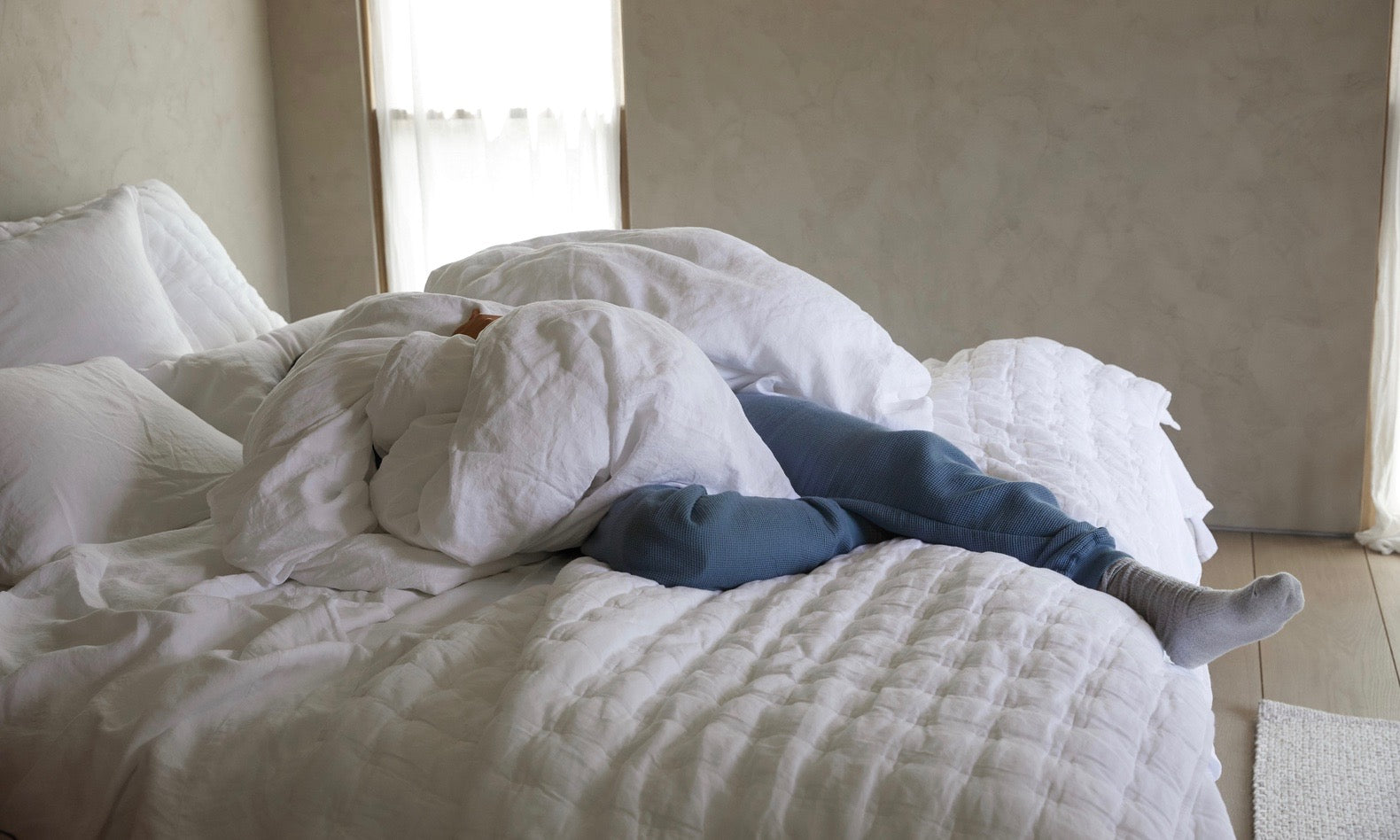
How to Wash, Dry and Care for Your Linen Sheets
Prolong the life of your most beloved bedding.
When it comes to natural bedding materials, linen is tough to beat. Made of flax fibers, the exceedingly strong yet undeniably soft textile is breathable, cozy and seasonless, keeping you warm in the winter and cool through the summer. Not only that, but it gets smoother, comfier and all-around better with every wash.
It's easy to see why people love this fabric. But since it comes at a slightly higher price than other materials, many wonder, “do linen sheets last longer than other sheets?” The short answer is yes, linen is incredibly durable, often lasting for a decade or more. The long answer is that proper maintenance is crucial for upholding the integrity and laid-back elegance of the beloved textile.
Parachute's linen bedding is relatively easy to maintain, but there are a few things to keep in mind when caring for the fabric. If you're considering investing in the effortlessly cool and widely cherished material or want to protect linens you already own, you've come to the right place. Here's how to wash linen sheets the right way, as well as how to dry, de-wrinkle, spot-treat and store your bedding.
How to Wash Linen Sheets: Steps and Best Practices
Ideal for hot and cold sleepers alike, brilliantly soft and airy linen is the perfect balance of casual and luxurious. To help the all-star textile retain its incredible texture and year-round appeal, it's important to know exactly how to keep linen sheets fresh. Read on for tips and guidance on how often to wash your bedding and what settings to wash linen sheets to avoid shrinking, discoloration and other damage.
How Often Should You Wash Linen Sheets?Many wonder how often to wash linen sheets, and the answer is generally the same as with all other bedding materials. Cleaning your fitted sheet, top sheet and pillowcases once a week is typically often enough to keep your sleeping environment healthy. And if you're worried about breaking down the fabric prematurely, you're in luck because linen actually gets better every time it goes through the wash.
Does Linen Shrink When Washed?Like cotton, it's possible for linen bedding to shrink in the wash. That's why it's critical to know what temperature to wash linen sheets and how to dry them so they fit properly on your mattress and pillows.
Learn more in our guide on How to Keep Linen Sheets From Shrinking?
Should You Wash Linen Sheets in Cold or Hot Water?The right temperature for cleaning linen is neither hot nor cold. Your best bet is lukewarm water – warm enough to eliminate bacteria and dissolve body oils and other residues, but not so hot that it breaks down the fibers or causes the fabric to shrink.
How to Wash Linen Sheets in a Washing MachineLinen might be a high-end fabric, but that doesn't mean it's high maintenance. You can clean it right at home in a standard washing machine. These are the basic steps:
Place your linen sheets in your washer on their own or with textiles of a similar color.
Add about a quarter-cup of mild laundry soap, like Parachute Laundry Detergent.
Set your washing machine to a gentle cycle and select a warm-water setting.
Start the cycle.
Best Practices for Washing Linen Sheets in a WasherPart of the appeal of linen is its simplicity — and cleaning the natural material is super simple too. Having said that, the following tips will help you make the most out of your linen sheets.
Carefully read the instructions (whether on the tag, packaging or website product description) before getting started.
Use a gentle or "delicate" cycle to protect the natural fibers.
Select a warm-water setting. Cold water works if you're concerned about shrinking, though hot water should always be avoided.
Opt for a mild liquid detergent formulated specifically for delicate fabrics.
Avoid soaps containing optical brighteners and other harsh chemical cleaning agents, as they can weaken and potentially discolor the fabric.
If possible, select the maximum water level to allow the fabric to move freely in the drum.
Use concentrated laundry soap sparingly. A quarter-cup is typically plenty, especially with a high-efficiency washing machine.
Consider filling your washer with water and adding the detergent before placing your sheets in the drum. This gives it time to fully dissolve and can help prevent staining.
Wash your linen sheets in their own load or with like colors. Additionally, you should only mix your linen bedding with items of similar weight, like lightweight clothing.
If you wash linen bedding with other items, just make sure they don't have any hooks or zippers that could snag the material.
A small or medium-sized load is best, as overcrowding can lead to tangling, cause the material to become misshapen and impact how well your bedding is cleaned.
Linen is naturally antimicrobial, meaning it won't harbor bacteria and resists mildew growth. And as you can see, cleaning this easy-breezy fabric doesn't require a whole lot of your attention.
How to Hand-Wash Linen BeddingOne of the appeals of linen sheets is that they're machine washable. But if you prefer the hand-washing route, you can apply the same best practices outlined above in terms of water temperature and detergent type.
Start by filling up your sink or bathtub with warm water.
Add a small amount of laundry detergent, allowing it to dissolve.
Lower your sheets into the soapy water until they're completely submerged.
Gently agitate the fabric with your hands for a few minutes, avoiding twisting or wringing the material.
Remove your sheets, then drain and rinse the basin.
Refill the basin with warm water and submerge your sheets again.
Massage the fabric in the clean water until the material is soap-free. Repeat this step if necessary to get rid of all the soap.
Parachute's all-natural laundry soap can be used for both machine washing and hand-washing. Aside from using lukewarm water and a mild liquid soap, make sure the detergent is rinsed entirely clean from the fabric before drying it.
How to Dry Linen SheetsNow that you know how to wash linen sheets, it's time to learn how to dry them properly. So, can you put linen in the dryer? Low-maintenance linen bedding can be tumble-dried on a low heat setting. However, many people opt to air-dry linen sheets partially, if not completely.
Air-drying helps preserve linen and supports the textile's long-term durability. If you're not in a time crunch, you can hang up your sheets as soon as you pull them out of the washer and let them air-dry all the way. But since air-drying can make linen bedding feel slightly stiff, you might consider a hybrid approach.
As soon as the wash cycle ends, pull your sheets out and place them in the dryer with wool dryer balls.
Run your dryer on a low-heat setting for 10 to 15 minutes.
Take your linen sheets out of the dryer when they're still somewhat damp.
Hang them up indoors or outside on a clothesline if the weather permits and allow them to dry the rest of the way.
Bear in mind that linen bedding dries a little faster than its cotton counterparts. You may want to start out with just eight minutes in the dryer to see how dry your sheets get, and then add a couple minutes as needed. Additionally, be careful where you hang them and when using clothespins to avoid creasing or puckering the fabric. Lastly, since the sun can bleach linen, it's best to place your sheets in a shaded area when drying them outdoors.
Consider Wool Dryer Balls When Drying Your Linen SheetsWhen drying linen bedding in a dryer, you can elevate the softness and make the material extra-fluffy with dryer balls. Unlike dryer sheets and most liquid fabric softeners on the market, Parachute's Wool Dryer Balls are an all-natural, eco-friendly, hypoallergenic product.
When tossed in the dryer with your linens, they increase airflow, helping to fluff up the textile and minimize wrinkles. Not only that, but Parachute's sustainable, chemical-free dryer balls can reduce drying time by as much as 50% — and they last for 1,000 cycles.
Linen Bedding Care and Maintenance
Now that you're briefed on the basics of how to clean linen sheets, you can broaden your knowledge further on caring for your bedding. Here's what you should know about preventing discoloration, stain removal, ironing and proper storage.
What Causes Linen Sheets to Discolor?There are a few things that can discolor linen. For one, bleach and harsh detergents can leave marks on the fabric, including dyed and dye-free linen, which has a natural off-white finish. That's why it's best to use a mild detergent. Non-chlorine (or color-safe) bleach can work for washing linen sheets, Still, it's best to avoid it if you're concerned about discoloration. Makeup and skincare products formulated with AHAs (alpha-hydroxy acids) can also leave stains.
How to Get Stains Out of Linen BeddingIt's best to clean stained bedding when the marks are still fresh, so as soon as you notice discoloration, toss your sheets in the wash. But before running them on a cleaning cycle, you can spot-treat stains with a sprinkle of baking soda and a few drops of distilled white vinegar. OxiClean can also work for treating stains.
Instead of scrubbing, gently blot the mark with the solution using a clean cloth until it appears clean, then wash your sheets as you normally would. For larger stains, you can also try adding about a cup of white vinegar and a couple tablespoons of baking soda to the load, along with a normal amount of laundry soap.
How to Iron Linen BeddingLinen bedding doesn't necessarily need to be ironed. The inherently casual material is known for its relaxed, lived-in appearance, and it'll smooth out when you make your bed. Also, slightly damp linen sheets are unlikely to wrinkle, so you might try making your bed just before they're completely dry. That being said, if you want to use an iron, make sure you set it to the lowest temperature.
How to Store Linen BeddingKnowing how to wash and dry linen sheets is only half of caring for the material and ensuring it lasts as long as possible. With that said, proper storage is essential, especially if you rotate your bedding with another set or keep extra linens on hand for guests.
The best way to store bed linens is in a bedding bag, whether you use the one your sheets came in or buy a new protective satchel. A cloth bag will keep dust mites at bay while safeguarding the fabric from direct sunlight, which can cause fading. Beyond that, stash your linen bedding in a dry, cool area — bathrooms, laundry rooms and other moisture-prone spaces aren't recommended.
Additionally, try to store your sheets somewhere that gets plenty of ventilation. Plastic storage bins should be avoided, as they're known to trap moisture and may cause mildew growth.
Where to Buy the Best Linen Bedding
With a thorough understanding of how to wash linen sheets, you can purchase a new set with confidence. If you treat your linen bedding with the care it deserves, you'll be repaid with comfy, cozy, increasingly soft sleeping quarters for years to come. The light and airy linen sheets, pillowcases, shams and duvet covers from Parachute are crafted from 100% European flax and expertly loomed in Portugal.
Ready to experience the unbeatable texture of linen bedding? Get a Parachute sheet set today, or order a fabric swatch to feel the unique, high-end fabric before you buy.
How to Wash, Dry, and Care for Sheets
How to Wash, Dry, and Care for Baby Blankets & Bedding
Sateen: Know Your Bedding Like a Designer
Percale: Know Your Bedding Like a Designer
Brushed Cotton: Know Your Bedding Like a Designer
Linen: Know Your Bedding Like a Designer
Satin vs. Sateen vs. Silk: What’s the Difference
Linen vs. Percale vs. Sateen: What's the Difference?
What is European Flax Linen? Why It’s the Best Linen Fabric
How to Recycle, Reuse, & Donate Old Sheets, Blankets, & Towels
What is GOTSⓇ Certified Organic Cotton?
What Is Oeko-Tex? Learn About This Textile Certification Standard
Best Sustainable Fabrics for an Eco-Friendly Home
Best Oeko-Tex Towels, Sheets, Shower Curtains, & More
How to Wash, Dry, & Care for Organic Cotton Sheets, Towels, & Clothes








